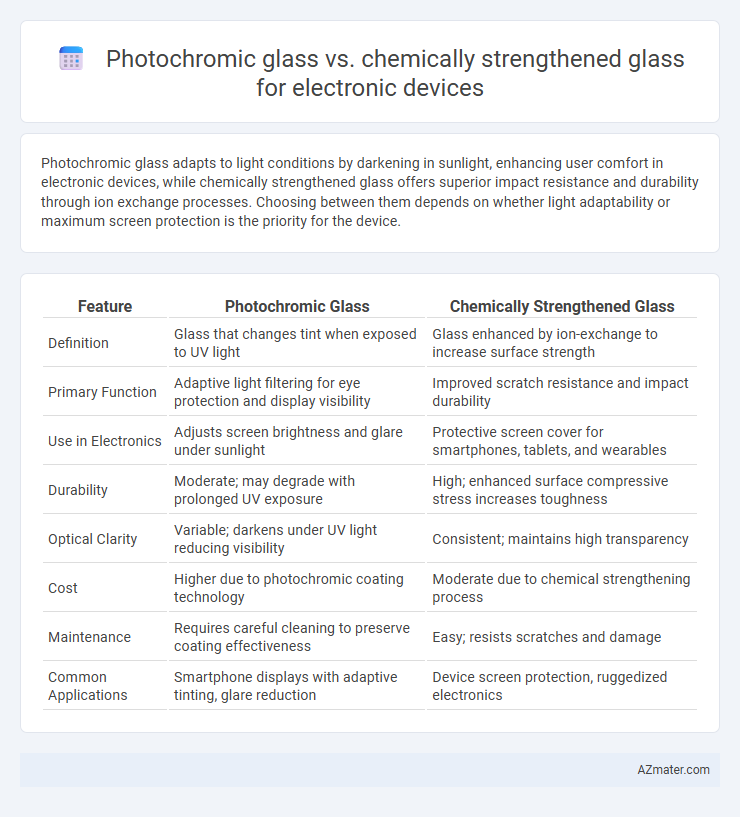Photochromic glass adapts to light conditions by darkening in sunlight, enhancing user comfort in electronic devices, while chemically strengthened glass offers superior impact resistance and durability through ion exchange processes. Choosing between them depends on whether light adaptability or maximum screen protection is the priority for the device.
Table of Comparison
| Feature | Photochromic Glass | Chemically Strengthened Glass |
|---|---|---|
| Definition | Glass that changes tint when exposed to UV light | Glass enhanced by ion-exchange to increase surface strength |
| Primary Function | Adaptive light filtering for eye protection and display visibility | Improved scratch resistance and impact durability |
| Use in Electronics | Adjusts screen brightness and glare under sunlight | Protective screen cover for smartphones, tablets, and wearables |
| Durability | Moderate; may degrade with prolonged UV exposure | High; enhanced surface compressive stress increases toughness |
| Optical Clarity | Variable; darkens under UV light reducing visibility | Consistent; maintains high transparency |
| Cost | Higher due to photochromic coating technology | Moderate due to chemical strengthening process |
| Maintenance | Requires careful cleaning to preserve coating effectiveness | Easy; resists scratches and damage |
| Common Applications | Smartphone displays with adaptive tinting, glare reduction | Device screen protection, ruggedized electronics |
Introduction to Photochromic and Chemically Strengthened Glass
Photochromic glass contains molecules that darken when exposed to ultraviolet light, providing dynamic light control and enhanced user comfort in electronic devices. Chemically strengthened glass undergoes an ion-exchange process, replacing smaller ions with larger ones to increase surface compressive stress, resulting in superior scratch resistance and mechanical durability. These properties make photochromic glass ideal for adaptive display screens, while chemically strengthened glass offers robust protection for touchscreens and electronic covers.
Key Properties of Photochromic Glass
Photochromic glass for electronic devices features dynamic light modulation, automatically darkening in response to UV exposure and enhancing screen visibility in bright environments while reducing eye strain. Its key properties include rapid color change, high optical clarity, and UV protection, contributing to energy efficiency by minimizing the need for external shading. Unlike chemically strengthened glass, which primarily offers enhanced mechanical strength and scratch resistance, photochromic glass combines adaptive functionality with durability, making it ideal for outdoor and wearable electronics.
Key Properties of Chemically Strengthened Glass
Chemically strengthened glass for electronic devices offers superior impact resistance and enhanced scratch durability due to its ion-exchange process, which creates a compressive stress layer on the surface. This glass provides excellent optical clarity and maintains high transparency while improving toughness compared to conventional glass types. Its resistance to surface damage and ability to withstand daily wear make it ideal for touchscreens and display covers in modern electronics.
Applications in Electronic Devices
Photochromic glass enhances electronic devices by automatically adjusting tint to optimize screen visibility in varying light conditions, improving user experience in smartphones, tablets, and smartwatches. Chemically strengthened glass offers superior durability and scratch resistance, essential for protecting displays from impact and wear in smartphones, laptops, and wearable devices. Combining photochromic properties with chemical strengthening creates innovative, resilient screens that adapt to environmental changes while maintaining structural integrity in electronic devices.
Light Sensitivity: Adaptive Features of Photochromic Glass
Photochromic glass offers superior light sensitivity by automatically adjusting tint levels in response to UV exposure, enhancing screen visibility and reducing glare for electronic devices used in varying lighting conditions. Chemically strengthened glass provides exceptional durability and scratch resistance but lacks adaptive light filtering capabilities essential for outdoor readability. The dynamic light modulation in photochromic glass contributes to improved user comfort and energy efficiency in electronic displays exposed to fluctuating ambient light.
Durability and Scratch Resistance: Chemically Strengthened Glass Benefits
Chemically strengthened glass offers superior durability and enhanced scratch resistance for electronic devices due to its ion-exchange process, which increases surface compressive stress and minimizes micro-cracks. Photochromic glass, while providing adaptive light filtering, generally lacks the same toughness and resistance to surface damage as chemically strengthened glass. Therefore, chemically strengthened glass is preferred for protecting sensitive screens against daily wear, impacts, and abrasions.
Cost Comparison: Photochromic vs Chemically Strengthened Glass
Photochromic glass typically incurs higher manufacturing costs due to the advanced technology required for light-sensitive molecules embedded in the glass, whereas chemically strengthened glass involves a more straightforward ion-exchange process that is generally less expensive. The enhanced durability and scratch resistance of chemically strengthened glass often justify its lower production cost in electronic devices, making it a cost-effective choice for mass-market applications. Photochromic glass adds functional value with its adaptive tinting but remains a premium option, significantly increasing overall device production expenses.
User Experience & Display Performance
Photochromic glass enhances user experience in electronic devices by automatically adjusting tint based on ambient light, reducing eye strain and improving screen visibility outdoors. Chemically strengthened glass offers superior durability and scratch resistance, maintaining display clarity and responsiveness under heavy use. Combining both technologies can optimize display performance by balancing adaptive visual comfort with robust protection.
Environmental Impact and Longevity
Photochromic glass adapts to light conditions by darkening under UV exposure, reducing the need for additional shading and lowering energy consumption, which contributes to environmental sustainability. Chemically strengthened glass undergoes an ion exchange process enhancing its durability and scratch resistance, extending the device's lifespan and minimizing electronic waste. Both materials improve electronic device longevity, but photochromic glass offers the added benefit of energy efficiency, while chemically strengthened glass emphasizes mechanical robustness.
Choosing the Right Glass for Your Electronic Device
Photochromic glass enhances user experience by dynamically adjusting tint based on light exposure, reducing glare and eye strain in electronic devices such as smartphones and tablets. Chemically strengthened glass offers superior durability and scratch resistance, providing robust protection against drops and daily wear, essential for maintaining device longevity. Selecting the right glass depends on prioritizing optical adaptability for outdoor use or toughness for everyday protection in electronic devices.

Infographic: Photochromic glass vs Chemically strengthened glass for Electronic device
 azmater.com
azmater.com